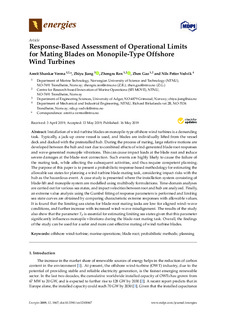| dc.contributor.author | Verma, Amrit Shankar | |
| dc.contributor.author | Jiang, Zhiyu | |
| dc.contributor.author | Ren, Zhengru | |
| dc.contributor.author | Gao, Zhen | |
| dc.contributor.author | Vedvik, Nils Petter | |
| dc.date.accessioned | 2019-09-24T12:19:41Z | |
| dc.date.available | 2019-09-24T12:19:41Z | |
| dc.date.created | 2019-09-20T11:29:36Z | |
| dc.date.issued | 2019 | |
| dc.identifier.citation | Energies. 2019, 12 (10), 1867-?. | nb_NO |
| dc.identifier.issn | 1996-1073 | |
| dc.identifier.uri | http://hdl.handle.net/11250/2618522 | |
| dc.description.abstract | Installation of wind-turbine blades on monopile-type offshore wind turbines is a demanding task. Typically, a jack-up crane vessel is used, and blades are individually lifted from the vessel deck and docked with the preinstalled hub. During the process of mating, large relative motions are developed between the hub and root due to combined effects of wind-generated blade-root responses and wave-generated monopile vibrations. This can cause impact loads at the blade root and induce severe damages at the blade-root connection. Such events are highly likely to cause the failure of the mating task, while affecting the subsequent activities, and thus require competent planning. The purpose of this paper is to present a probabilistic response-based methodology for estimating the allowable sea states for planning a wind-turbine blade-mating task, considering impact risks with the hub as the hazardous event. A case study is presented where the installation system consisting of blade-lift and monopile system are modelled using multibody formulations. Time-domain analyses are carried out for various sea states, and impact velocities between root and hub are analyzed. Finally, an extreme value analysis using the Gumbel fitting of response parameters is performed and limiting sea state curves are obtained by comparing characteristic extreme responses with allowable values. It is found that the limiting sea states for blade-root mating tasks are low for aligned wind–wave conditions, and further increase with increased wind–wave misalignment. The results of the study also show that the parameter Tp is essential for estimating limiting sea states given that this parameter significantly influences monopile vibrations during the blade-root mating task. Overall, the findings of the study can be used for a safer and more cost-effective mating of wind-turbine blades. | nb_NO |
| dc.language.iso | eng | nb_NO |
| dc.publisher | MDPI | nb_NO |
| dc.relation.uri | https://www.mdpi.com/1996-1073/12/10/1867 | |
| dc.rights | Navngivelse 4.0 Internasjonal | * |
| dc.rights.uri | http://creativecommons.org/licenses/by/4.0/deed.no | * |
| dc.title | Response-Based Assessment of Operational Limits for Mating Blades on Monopile-Type Offshore Wind Turbines | nb_NO |
| dc.type | Journal article | nb_NO |
| dc.type | Peer reviewed | nb_NO |
| dc.description.version | publishedVersion | nb_NO |
| dc.source.pagenumber | 1867-? | nb_NO |
| dc.source.volume | 12 | nb_NO |
| dc.source.journal | Energies | nb_NO |
| dc.source.issue | 10 | nb_NO |
| dc.identifier.doi | 10.3390/en12101867 | |
| dc.identifier.cristin | 1727141 | |
| dc.relation.project | Norges forskningsråd: 223254 | nb_NO |
| dc.relation.project | Norges forskningsråd: 237929 | nb_NO |
| dc.description.localcode | © 2019 by the authors. Licensee MDPI, Basel, Switzerland. This article is an open access article distributed under the terms and conditions of the Creative Commons Attribution (CC BY) license (http://creativecommons.org/licenses/by/4.0/). | nb_NO |
| cristin.unitcode | 194,64,20,0 | |
| cristin.unitcode | 194,64,92,0 | |
| cristin.unitname | Institutt for marin teknikk | |
| cristin.unitname | Institutt for maskinteknikk og produksjon | |
| cristin.ispublished | true | |
| cristin.fulltext | original | |
| cristin.qualitycode | 1 | |

